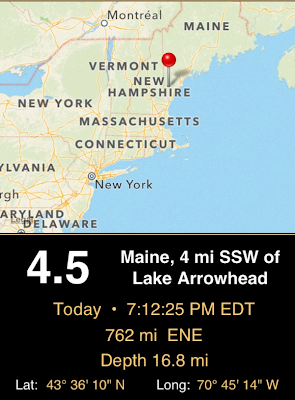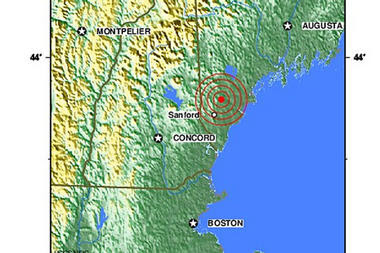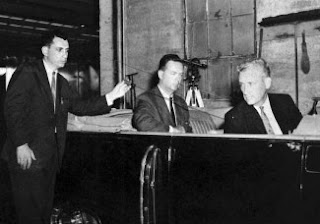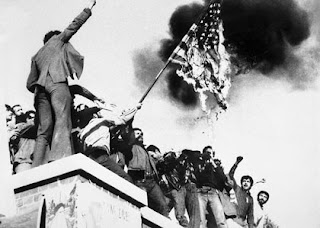The mainstream media groups have seemingly moved on from mass shootings that began with the Colorado Aurora (
red dawn) event at a movie theater on July 20, 2012, to the American embassy violence of September 11, 2012. But were some of these events foreshadowed by a science fiction visionary?
The Shah’s Exile and Khomeini’s Return, 1979. Artist: Hasan Isma’ilzadah.
Americans don't forget, and many this week are reminded of Tehran, Iran, November 4, 1979, when the U.S. embassy was taken over and then Americans were held hostages for 444 days, until January 20, 1981.
Synchronicity emerges, and recent events in Egypt and Libya are going to soon merge with and be mirrored in a movie about those times. Believe it or not, comic book genius Jack Kirby and a familiar location are part of the true story upon which the film is based.
That's right...
"Jack Kirby, the visionary madman who unwittingly changed the face of popular culture," as Christopher Loring Knowles
characterizes him on his blog Secret Sun.
The way all of this is going to unfold is through the movie
Argo, an American political intrigue film based on
Tony Mendez's account of the rescue of six U.S. diplomats from Tehran, Iran during the 1979
Iran hostage crisis. Filming began in September 2011, and the movie is scheduled to be released October 12, 2012.
The governments of the United States and Canada partnered to rescue six U.S. foreign service members who had evaded the hostage-taking at the takeover of the American embassy in Iran by staying in the home of the Canadian Ambassador. The governments were able to convince Iran that the six hostages were members of a film crew who were scouting the area for a movie titled Argo. The CIA's fake production company used real designs by comics legend Jack Kirby and Barry Ira Geller's screenplay for the upcoming film Lord of Light. Using John Chambers' idea for the caper, Mendez admitted stealing designs and screenplay from Geller's film production. Armed with professional designs and screenplay, the hostages were successfully able to escape the country under their fake identities, notes Wikipedia.
Knowles talks of this incident in 2008, on his blog,
when he says, in part:
...Kirby was hired to do design work for one of those post-Star Wars pipe dreams- a major motion picture based on Roger Zelzany's 1967 novel, Lord of Light.
Drawing on the same themes Kirby mastered with The Eternals and The New Gods, Lord of Light played directly into Kirby's greatest strengths as a designer and visionary. Kirby was also contracted to make designs for a multi-million dollar theme park, whose preposterous untenability boggles the mind. Sadly and predictably, the project ran a[g]round after a producer made off with the seed money for the project.
Here's where I began to freak out, a bit, as I was researching this today, in Loring's and others accounts. The designs for Jack Kirby's Science Fiction Land theme park were an important part of the cover story to convince the Iranians this was all authentic. Most of the time people don't mention where this theme park was suppose to be in the general accounts about Argo.
But digging deeper, I discovered it was in Aurora, Colorado!
Jack Kirby (August 28, 1917 – February 6, 1994),
born Jacob Kurtzberg, was a visionary.
This has been a banner year for "The King of Comics,"
with The Avengers and Prometheus (heavily based on
his 70s epic The Eternals) cleaning up at the box office.
Okay, Knowles may be obsessed with Kirby. After all, CLK's written 85 (!) blog postings about the guy. But there's a good reason why he is.
Knowles also mentions another person of note:
One of the artisans signed on to bring Lord of Light to life was Planet of the Apes makeup maestro John Chambers, who doubled as a disguise maker for the CIA. A fellow agent contacted him, looking for an abandoned script to use to coax the newly-installed Iranian mullahs into signing on to a film project. The Iranians needed money and were looking to set up business deals to keep the revolution afloat. The CIA in turn was looking to sneak some hostages out of the country, and needed ideas. One enterprising agent was looking to cozy up to the mullahs by pitching a film project to them. In those days, Hollywood's eldritch power could soften the most hard-bitten theocrats.
John Chambers? Yes, John Chambers. I was involved with the investigations about whether or not Chambers was behind some famous and infamous Bigfoot stories. I also wrote his
obituary, which was picked up by various mainstream outlets.
I penned the following about Chambers:
John Chambers, who once created a Bigfoot carnival prop and was rumored to be behind the Patterson-Gimlin Bigfoot footage, died of diabetes complications, 25 August 2001, at the Motion Picture and Television Fund retirement home in Woodland Hills. He was 78.
***
During his 30-year career, Chambers worked on several movies and television shows, including TV's The Outer Limits, The Munsters, Lost in Space and Mission Impossible. Chambers was responsible for putting the pointy ears on Star Trek's Mr. Spock. His makeup and prosthetics film credits included National Lampoon's Class Reunion (1982), Halloween II (1981), The Island of Dr. Moreau (1977), SSSSSSS (1973), Battle for the Planet of the Apes (1973), Superbeast (1972), Conquest of the Planet of the Apes (1972), Slaughterhouse-Five (1972), Escape from the Planet of the Apes (1971), Beneath the Planet of the Apes (1970), Planet of the Apes (1968), The List of Adrian Messenger (1963), and Showdown at Boot Hill (1958).
***
Chambers' first of only a few acting appearances was in a 1971 movie about a California Bigfoot that terrorized co-eds. The film, Schlock was directed by John Landis, who also played the film's very thin Bigfoot. Chambers played the National Guard Captain in the film. Chambers' student, Rick Baker, who one day would create Harry in Harry and the Hendersons, did the makeup and created the Bigfoot in Schlock.
So why Chambers? He was also an old CIA subcontractor. John Chambers was "given the highest civilian award from the CIA for his help with numerous transformations. Some of his work can be seen at the International Spy Museum in Washington D.C. He also set up the cover story of a film crew planning to shoot a science fiction film in Iran for his special effects colleague Tony Mendez in order to rescue some American embassy personnel who escaped capture by the Iranian militants in November 1979," mentions his
Wikipedia entry.
Knowles points out that
Wired delved into the Iranian episode further,
in depth:
[Barry] Geller imagined a Colorado theme park based on Kirby's set designs that would be called Science Fiction Land; it would include a 300-foot-tall Ferris wheel, voice-operated mag-lev cars, a "planetary control room" staffed by robots, and a heated dome almost twice as tall as the Empire State Building.
Geller had announced his grand plan in November at a press conference attended by Jack Kirby, former football star and prospective cast member Rosey Grier, and several people dressed like visitors from the future. Shortly thereafter, Geller's second-in-command was arrested for embezzling production funds, and the Lord of Light film project evaporated. Since Chambers had been hired by Geller to do makeup for the film, he still had the script and drawings at his house. The story, a tale of Hindu-inspired mystical science fiction, took place on a colonized planet. Iran's landscape could provide many of the rugged settings required by the script.
He (Mendez) removed the cover and gave the script a new name, Argo — like the vessel used by Jason on his daring voyage across the world to retrieve the Golden Fleece.
Joshuah Bearman in
Wired, April 24, 2007, tells more details of the story in "
How the CIA Used a Fake Sci-Fi Flick to Rescue Americans from Tehran." Here are some selections from that piece:
***
To build his cover, Mendez put $10,000 into his briefcase and flew to Los Angeles. He called his friend John Chambers, the veteran makeup artist who had won a 1969 Academy Award for Planet of the Apes and also happened to be one of Mendez’s longtime CIA collaborators. Chambers brought in a special effects colleague, Bob Sidell. They all met in mid-January and Mendez briefed the pair on the situation and his scheme. Chambers and Sidell thought about the hostages they were seeing each night on television and quickly declared they were in.
In just four days, Mendez, Chambers, and Sidell created a fake Hollywood production company. They designed business cards and concocted identities for the six members of the location-scouting party, including all their former credits. The production company’s offices would be set up in a suite at Sunset Gower Studios on what was formerly the Columbia lot, in a space vacated by Michael Douglas after he finished The China Syndrome.
All they needed now was a film — and Chambers had the perfect script. Months before, he had received a call from a would-be producer named Barry Geller. Geller had purchased the rights to Roger Zelazny’s science fiction novel, Lord of Light, written his own treatment, raised a few million dollars in starting capital from wealthy investors, and hired Jack Kirby, the famous comic book artist who cocreated X-Men, to do concept drawings. Along the way, Geller imagined a Colorado theme park based on Kirby’s set designs that would be called Science Fiction Land; it would include a 300-foot-tall Ferris wheel, voice-operated mag-lev cars, a “planetary control room” staffed by robots, and a heated dome almost twice as tall as the Empire State Building. Geller had announced his grand plan in November at a press conference attended by Jack Kirby, former football star and prospective cast member Rosey Grier, and several people dressed like visitors from the future. Shortly thereafter, Geller’s second-in-command was arrested for embezzling production funds, and the Lord of Light film project evaporated.
Since Chambers had been hired by Geller to do makeup for the film, he still had the script and drawings at his house. The story, a tale of Hindu-inspired mystical science fiction, took place on a colonized planet. Iran’s landscape could provide many of the rugged settings required by the script. A famous underground bazaar in Tehran even matched one of the necessary locations. “This is perfect,” Mendez said. He removed the cover and gave the script a new name, Argo — like the vessel used by Jason on his daring voyage across the world to retrieve the Golden Fleece.
[Finally, the plot was put in place, the cover stories worked at the airport, and the time to catch the flight was upon them....]
A mechanical problem caused a delay, and the Revolutionary Guards were starting to turn their attention to foreign passengers.
Mendez disappeared. He had a contact at the airport and went to check on the flight status. No sooner had he learned that the delay would be short than they heard the announcement: “Swissair flight 363, ready for immediate departure.” As they boarded the plane from the windy tarmac, Anders noticed the word AARGAU was printed across the fuselage — the name of the Swiss region where the plane originated was strangely similar to that of their cover story. He punched Mendez’s arm and said, “You guys arrange everything, don’t you?”
What we see here is even a synchromystic link within their story. Argo-Aargau shows up in this story. The Swissair name was because of a section of the country.
Aargau is one of the more northerly cantons of Switzerland. It comprises the lower course of the river Aare, which is why the canton is called
Aar-gau. In the 17th century, Jews were banished from Switzerland. However, a few families were permitted to live in two villages, Endingen and Lengnau, in
Aargau which became the Jewish ghetto in Switzerland.
Aargau shows up in the
Star Wars universe as a planet in the Zug system of the Core Worlds region, not far from Coruscant and the Corellian Run. It was run by and served as the headquarters for the
Bank of Aargau, which was part of the InterGalactic Banking Clan.
The elimination of the true role Barry Ira Geller's Lord of Light film project and its Jack Kirby production designs played in the real-life caper may cost the film several million Kirby/Zelazny-fan tickets! What a lost opportunity! And for what? affleck was stuck on the film being all about him in the leading role and wanted the rights to mine and Jack Kirby's work for nothing. When I and maybe the Kirby Estate said no, how about a few shekels, he just cut us out! Is that a financially a responsible executive decision?
The plan to use a desert-based SCIFI movie as the very basis to get the six Americans out of Iran was totally John Chambers' idea, based upon his recent employment for my film production, Lord of Light; it was John's standing in the film industry (Oscar winner, etc.) -- not Tony Mendez's (affleck's character) -- who up to that point was totally unfamiliar with film business infrastructure (his own admission). Chambers did everything out of patriotism to our country and deserves the credit for this caper he has never publicly received.
The choice of the name
Argo is intriguing. In Greek mythology, the
Argo (in Greek: Ἀργώ, meaning 'swift') was the ship on which Jason and the Argonauts sailed from Iolcos to retrieve the Golden Fleece. It was named after its builder, Argus.
But that Kirby's Science Fiction Land was to be at Aurora, Colorado, results in another coincidence, the location of a famed mine near there: The Argo Tunnel. This site was originally called the Newhouse Tunnel (after Salt Lake City mining magnate Samuel Newhouse). It is a 4.16 miles mine drainage and access tunnel with its portal at Idaho Springs, Colorado, not really too far from Aurora. The tunnel intersected nearly all the major gold mines between Idaho Springs and Central City, and is the longest such drainage tunnel in the Central City-Idaho Springs mining district.
There is a documentary in the works about Geller and his attempts to film
Lord of Light and the plans for the huge SciFi theme park called
ScienceFictionLand, by award-winning documentary director Judd Ehrlich.
Bucky Fuller had an idea to build a domed city (above), also envisioned by Jack Kirby as Science Fiction Land (seen at top). There is also such a city, intriguing named
Argo City, appearing in
Superman Annual 1, September 1960, by Jerry Siegel (below).






















































